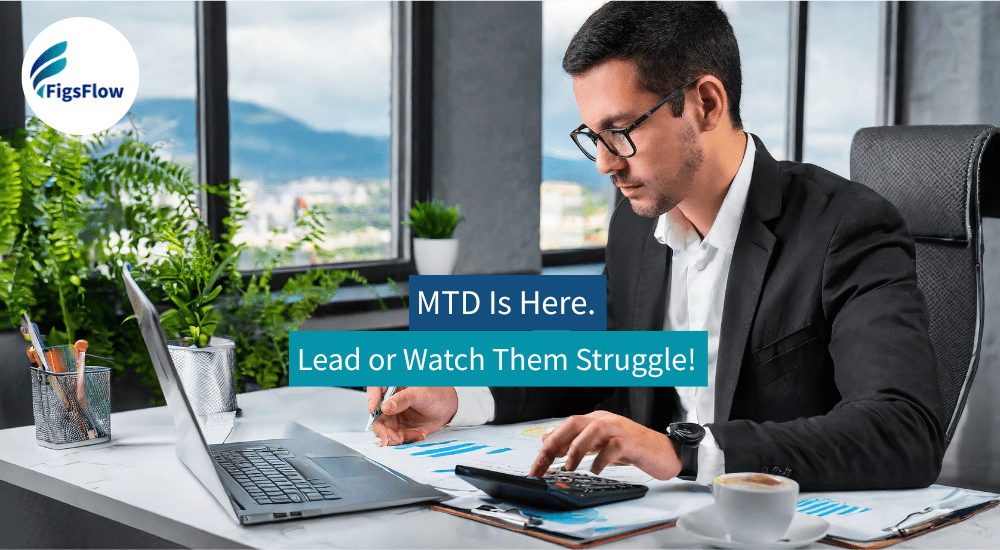April 2026 will mark one of the biggest shifts in how small businesses, landlords, and the self-employed manage their tax affairs. For many clients, it’s a complete shift in how they handle records, deadlines and compliance.
That’s where you come in.
As an accountant, your role is no longer limited to producing annual returns. Over the next phase of Making Tax Digital (MTD), you’ll become the translator, the problem-solver, and the steady hand guiding clients through unfamiliar systems, stricter deadlines, and the pressure of “always-on” compliance.
The question isn’t whether your clients will comply with MTD, they don’t have a choice. The question is whether they’ll do it confidently with your support, or whether they’ll struggle through without clear guidance.
This guide lays out the practical steps you can take to support clients every step of the way and position your firm as their go-to partner for navigating MTD successfully.
Step 1: Identify & Prioritise Your Client Support Needs
Start by identifying who needs your help and how urgently they need it. The deadlines are staggered, so not all clients will be affected at the same time:
- April 2026 – Self-employed clients and landlords earning over £50,000
- April 2027 – Self-employed clients and landlords earning over £30,000
- April 2028 – Self-employed clients and landlords earning over £20,000
Every client within these thresholds will need HMRC-recognised software in place before their relevant deadline. Your role is to make sure they’re ready well in advance, avoiding last-minute stress or compliance risks.
Start by creating a systematic assessment for each client. Look at:
- Total qualifying income from self-employment and property (remember, the threshold is combined, not per source)
- Current record-keeping methods; are they using spreadsheets, manual logs or cloud systems?
- Technology comfort level; will they adapt quickly or need extra guidance?
- Income status; do they have multiple income streams, partnerships, or joint properties?
- Historical compliance issues like late filings, errors, or recurring mistakes
Once you have this information, document each client’s specific support needs. A landlord with three properties will need very different guidance than a sole trader electrician.
Immediate Action: Use a Client Assessment Questionnaire to systematically evaluate your entire client base this month. This will give you a clear picture of who to support first, what guidance they need, and how to plan your engagement in line with the MTD timeline.
Step 2: Create Your Client Education Programme
For many clients, the challenge with MTD isn’t the technical requirements. It’s not understanding what’s expected of them. That uncertainty can feel overwhelming, especially with new software, quarterly deadlines, and digital record keeping obligations. Your role is to guide them step by step, breaking the process into manageable stages.
Start early and plan your education around key milestones in the months leading up to each client’s MTD deadline. You can begin with an overview of what MTD means for their business, then then help them evaluate and choose the right software and finally walk through implementation and preparation of live reporting.
A practical way to structure this is to focus on four key stages:
- Overview Sessions – Explain what MTD means for individuals, their businesses and why it matters.
- Software Guidance Workshops – Help clients evaluate and choose HMRC-recognised software.
- Implementation Planning Meetings – Walk through the steps to be ready for live reporting.
- Ongoing Support – Provide guidance and reminders aligned with quarterly reporting.
To make the program scalable and consistent, prepare a standard presentation or guide that you can customise for different client groups. Include examples that reflect their specific business scenarios so clients can see exactly how MTD will affect them.
Step 3: Guide Clients Through Software Selection
Once you’ve assessed your clients’ needs, the next step is recommending the right software. Clients rely on your expertise to choose solutions that will work for their specific circumstances and be ready for their MTD deadline.
The software selection process can be structured as follows:
- Identify Requirements – Consider income sources, accounting period, and any integration needs with existing systems.
- Shortlist Options – Narrow down 3/4 suitable HMRC-recognised software solutions.
- Trial & Evaluation – Coordinate trial periods and provide clear criteria for assessing functionality.
- Decision Support – Help clients weigh costs against features and confirm readiness for their MTD deadline.
- Implementation Planning – ensure the chosen software is fully set up before live reporting begins.
By following this process, clients can make informed decisions with confidence, and you can avoid last-minute issues. Offer to attend software demonstrations with clients where possible. Your questions will highlight considerations clients might miss and demonstrate your support.
Here are some resources you can consider for software selection:
Step 4: Implement Client Onboarding Systems
Smooth onboarding is key to keeping MTD implementation on track. You need a workflow that’s integrated, organised, and doesn’t force you to juggle multiple platforms. Clear guidance on HMRC authorisation, data migration, and setup ensures clients feel supported while giving you control over the process.
That’s where FigsFlow comes in. As a proposal, pricing, and engagement platform for accountants, it’s soon launching AML checks, creating the first truly all-in-one onboarding solution. By centralising KYC, CDD, and AML checks in one platform, FigsFlow makes compliance faster, easier, and more reliable.
With FigsFlow, you can:
- Securely collect client data and documents in one place
- Automate risk assessments and client categorisation
- Support enhanced due diligence for high-risk clients
- Maintain a clear audit trail and reduce manual errors
The platform also includes ready-to-use engagement letters and proposal templates for services like MTD and directors’ ID verification, helping you onboard clients professionally and efficiently.
Don’t wait. Get started today with FigsFlow and experience how an integrated onboarding platform can simplify client onboarding across all services, including MTD, while helping you stay compliant.
Step 5: Establish Ongoing Client Support Workflows
MTD success depends on consistent quarterly performance, not just good initial setup. Once clients are live, you need a clear, repeatable support workflow that ensures deadlines are met, records are accurate, and issues are resolved before they become problems.
Begin by structuring your Quarterly Support Cycle:
| Pre-Deadline (2 weeks before submission) |
Submission Period (Final week before deadline) |
Post-Submission (within a week of deadline) |
|---|---|---|
| Send reminder emails | Process quarterly submissions | Send confirmation communications to clients |
| Review client’s record-keeping | Review estimates and discuss with clients | File submission evidence |
| Identify and resolve any issues early | Document any issues for future improvement | Update client records with lessons learned |
| Schedule submission appointments for clients | Confirm successful submission | Schedule any necessary follow-ups |
Provide clients with simple, visual record-keeping guidance showing how to categorise common transactions, when to record them, what supporting documents to keep, and how to handle unusual or complex cases.
Finally, establish clear problem resolution protocols. For software issues, direct clients to provider support. For HMRC submission problems, you intervene with dedicated MTD assistance. For client process errors, provide additional training or adjust systems. And for any deadline pressure situations, have emergency procedures ready to keep everything on track.
With this structure, clients stay compliant and confident, and your practice can manage quarterly MTD obligations efficiently and proactively.
Step 6: Handle Client Resistance and Concerns
Not every client will embrace MTD enthusiastically. Anticipate common objections from clients and prepare your responses.
For example, if a client says, “I don’t want to change my current system,” you can prepare your response like: “We can make MTD work with minimal disruption. Bridging software may let you continue using your existing spreadsheets while meeting the new requirements.”
For clients worried about costs, you can create a cost comparison tool showing cost of compliance vs non-compliance penalties, benefits of quarterly updates vs annual surprises, value of improved business visibility and time savings from automated processes.
Next offer flexible support levels to match different clients’ needs and budgets:
- Full Service – You handle all MTD requirements.
- Guided Self-Service – Client manages day-to-day, you provide quarterly support.
- Training & Oversight – Client learns the systems with your ongoing guidance.
For those interested in understanding how to price MTD services effectively while considering these options, check out our detailed guide here.
By combining clear cost justification with flexible services options, you address client concerns proactively. This approach reassures clients, reduces resistance, and positions you as a trusted partner.
Step 7: Build Your Internal Support Infrastructure
Supporting clients effectively requires internal systems that can handle increased complexity and interaction frequency.
Focus on staff preparation. Ensure client facing team members understand MTD requirements, are confident with the software you support, and can explain complex processes clearly.
Next, establish standardised processes to maintain consistency and quality across your practice.
- Client onboarding workflows
- Quarterly submission procedures
- Problem escalation and resolution steps
- Quality assurance checks
- Clear client communication standards
Your systems should securely store client data, support multiple software platforms, provide automated reminders for deadlines, and keep documents organised.
Step 8: Measure Client Support Success
To ensure your MTD support is effective, it’s important to track performance and identify areas for improvement. Start by monitoring key implementation indicators, such as:
- Percentage of qualifying clients successfully onboarded by the relevant MTD deadline
- Client satisfaction with software selection
- On-time completion of quarterly submissions
- Retention of clients throughout the MTD transition
Equally important is measuring client satisfaction. Look at feedback scores on support quality, the frequency of client-initiated problem contacts, referral rates from satisfied clients, and renewal rates after the first year of MTD.
Pay attention to early warning signs that a client may be struggling, including missed record-keeping deadlines, repeated software issues, avoidance of MTD communications, or questions about changing accountants. Catching these early allows you to intervene proactively.
Finally, establish a continuous improvement process. Regularly review client support metrics each month, gather feedback from clients quarterly, and conduct an annual review of internal processes, tools, and software provider relationships. This cycle helps you refine your approach, address gaps, and ensure your practice continues to deliver smooth, reliable, and confident MTD support.
Bonus: Client Support Toolkit
Conclusion
The next phase of Making Tax Digital is a chance to strengthen your relationships with clients and show the value you bring beyond traditional accounting. By guiding them through each step, from software selection to ongoing support, you can help them navigate changes with confidence and clarity.
Investing in structured workflows, internal support, and practical tools ensures you are ready to meet challenges head-on. The result is a smoother experience for your clients and a stronger, more trusted position for your firm in a changing landscape.


